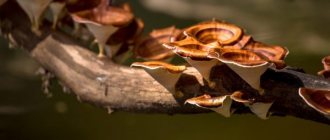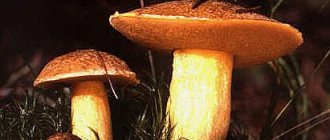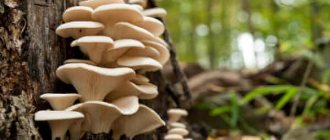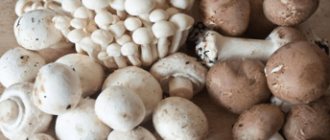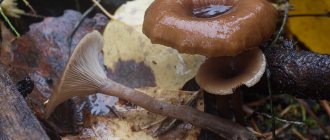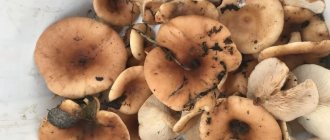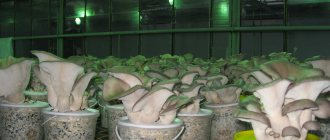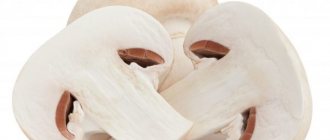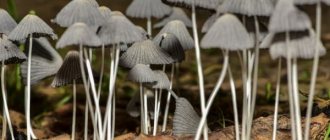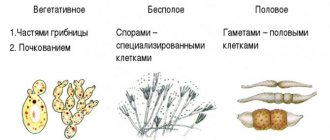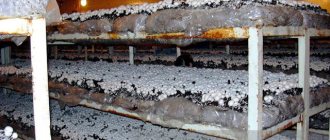Mushrooms
0
1656
Article rating
Kira Stoletova
The nutrition of fungi is heterotrophic. This is a complex process that combines mechanisms characteristic of animals and plants. It is unique; these organisms represent a separate kingdom with its own characteristics. Some species get everything they need from a dead substrate, while others parasitize living creatures.
Features of mushroom nutrition
What is mushroom nutrition?
By type of nutrition, mushrooms are heterotrophs. They absorb mineral substances from the space surrounding them, and organic substances only in a ready-made state. They grow in certain places where they can get all the necessary nutrients.
It is not typical for mushrooms to feed on bulky food particles. They absorb only liquid compounds throughout the body. This is exactly what the mycelium surface is very suitable for.
External digestion of mushrooms is considered to be the release of enzymes that promote the breakdown of polymers into monomers. And the latter are easily absorbed in the cytoplasm.
A number of fungi have the ability to secrete the types of enzymes that they need at a particular moment. For example, if it is necessary to break down proteins, they release proteases, if fats, then lipases, and if complex sugars, then carbohydrates are released. Thanks to these properties, they can grow on almost any surface.
There are also representatives of this kingdom that have only one specific enzyme and therefore are able to live only on the substrate that contains the substance they need.
Aerobic and anaerobic heterotrophic organisms
Anaerobes live in places where there is no oxygen. For them, this element, oddly enough, is toxic. Therefore, they obtain energy for life through so-called phosphorylation. This process occurs through the breakdown of amino acids and proteins.
Fermentation breaks down glucose and other glucose-like substances. The processes known to us - lactic acid, alcohol, and methane fermentation - are anaerobic.
Aerobic life forms of the heterotrophic type live only on oxygen. All these bacteria have a fairly diverse respiratory chain. It helps them adapt to different concentrations of oxygen in the air.
Heterotrophs obtain energy by oxidizing ATP (adenosine triphosphate, the most important protein compound), for which they need oxygen. However, a large amount of oxygen does not mean that microorganisms can exist in such an atmosphere. It has been experimentally proven that if the amount of free O2 in the atmosphere reaches half of the total volume, then the development of almost all known bacteria will stop. And in an atmosphere of pure 100% oxygen, not a single simple organism, not even prokaryotes, can develop.
In general, the role of heterotrophic microbes in nature is enormous. Without them, the development of any higher organisms is impossible. Without exaggeration, we can say that they are the basis of life on Earth.
Features of mushroom nutrition
There are some peculiarities in the nutrition of mushrooms. Based on their type, fungi are classified as heterotrophs. This is perhaps the most important difference between these organisms and plants. The diet of mushrooms is very diverse. Its source is two types of nutrients at the same time:
– organic compounds obtained from other organisms;
– mineral compounds obtained from moisture.
In the processing of dead plant tissues, it is impossible to do without the participation of fungi. They promote the breakdown of cellulose, which makes up the walls of plants.
The most nutritious substances for fungi are plant roots, animal corpses and various plant debris.
How do hetero-organisms feed?
Heterotrophs and autotrophs are closely related to each other. After all, the survival of these microorganisms is directly related to the presence of autotrophic creatures. Chemotrophs also fall into this category. It turns out that these voracious microcreatures consume what autotrophs have produced for them.
All heterotrophs are divided into these types.
- Molds and yeasts that feed on prepared foods. This most clearly distinguishes such bacteria - whether they are autotrophs or heterotrophs.
- Bacteria, called heterotrophs saprophytes, feed on dead food.
- Heterotrophs, whose nutrition comes from living beings. They are pathogenic.
Some types of heterotrophic bacteria have a similar diet to that of chemosynthetics. Thus, they oxidize organic compounds without assimilating acid. This type of nutrition is intermediate. However, the features of such transitional types of organisms, which feed in the same way as chemotrophs, find their application in various types of human economic activity.
Division of mushrooms according to feeding method
Depending on their food sources, mushrooms are divided into 4 groups:
- Saprophytes, which eat dead organisms. They contribute to the decomposition of animal and plant organisms. They live in soil and forest litter, where there is a lot of organic debris.
- Parasitic that penetrate living organisms. And their hyphae are able to grow into the cells of their donor and draw out nutrients from them. To absorb molecules of organic substances, mushrooms release enzymes into the substance. With their help, organic substances are broken down into low molecular weight compounds. And already in this form they are suitable as food for mushrooms (with an osmotrophic type of digestion). This is external digestion.
- Predatory mushrooms are fungi that actively hunt their target using hyphae and hunting loops.
- Symbiotic fungi that enter into mutually beneficial coexistence with autotrophic plant organisms. The essence of this interaction is that fungi use the organic substances of another organism, supplying it with the necessary minerals in return.
Nutrition of parasitic fungi
This method of feeding is typical for those fungi that by their nature live on other organisms. Most often, these are tree stumps. Dilapidated trees. Parasites include honey mushrooms and tinder fungi.
On their fruiting bodies there are processes, haustoria. Thanks to them, mushrooms can penetrate the walls of living organisms and thereby extract all the useful components from them.
Parasites also have their own peculiarity: after the donor is completely devastated, they live on it for some time. And during this period, the mushrooms become saprophytes.
Nutrition of molds
Molds do not have a specific type of nutrition. There are species that grow on materials that are subject to putrefactive processes. They perform a very useful function. During their destructive action, they pull out all organic residues from the environment in which they grow and partially release carbon compounds back into the environment. Thus, mold enriches the soil with essential nutrients.
But as for the colonies of mold fungi that live in urban environments. They lead to damage to food, homes and other premises used by people.
If we look at it on a large scale, the nutrition of mold fungi is the most important process that contributes to the saturation of the soil with minerals. Also, thanks to the vital processes of such fungi, the carbon cycle occurs in nature.
The list of foods that saprotrophs (useful types of mold) feed on includes: sugar, cellulose, organic acids and protein compounds.
Molds with a saprotrophic method of nutrition have very high resistance to unfavorable conditions. Their colonies can survive even with minimal humidity, lack of nutrients, and even with increased radiation.
When colonies form on rocky surfaces, cement or metal-plastic objects, they quickly grow and develop, and also synthesize carbon into the environment.
The deterioration of the ecological condition on Earth does not affect the viability of molds. Over 200 species of molds live in the exclusion zone at the Chernobyl nuclear power plant. They grow and develop very well in an environment with a lethal dose of radiation.
They also feed on gastronomy products: they can live on kitchen surfaces, in refrigerators, and in warehouses where food is stored. There is also a lot of breeding ground for mold among waste and garbage.
Habitats of phototrophic bacteria
Phototrophic bacteria are distributed mainly in salt and fresh water bodies. Most often they live in places with the presence of hydrogen sulfide. They can be located at any depth. Such organisms are rarely found in soils, but if the land is flooded, intensive growth of phototrophs located in it can be observed.
The development of phototrophs is easy to notice even without microscopic examination and installation of enrichment cultures, since they often cover underwater objects with bright films. Sulfur springs, bays, estuaries, ponds and lakes are full of such phototrophic accumulations. With the massive development of these organisms, the color of the reservoir in which they live may change. With a small amount of bacteria, only some layers of water are colored. Coloration of several water layers usually occurs at the bottom of lakes where hydrogen sulfide is present.
Nutrition of higher fungi
Higher fungi are characterized by heterotrophic nutrition. They independently synthesize organic substances from inorganic compounds. Thus, the mycelium uses organic substances that are transformed through plant photosynthesis. They also need minerals found in the soil. Everything that is necessary for growth and development is taken from the outside by higher mushrooms.
Mycelium is characterized by the release of an enzyme that promotes the breakdown of products. After processing, they are absorbed using hyphae. During this process, nutrients are absorbed into the cells of the fungal body.
Higher mushrooms are able to feed in three ways:
- As saprotrophs (saprophytic method). This is characteristic of many higher mushrooms. The role of food for them is played by the remains of animals, plants, forest litter, and roots of trees that have already begun to rot. Enzymes are secreted from the hyphae, which accelerate the breakdown of substances that are formed during decay. Products are broken down by hydrolysis. After processing, the products are absorbed through the hyphae and pass to the mycelium.
With the help of mold fungi, organic substances decompose, then bacteria join them.
Saprotrophs play a very important role in nature: they contribute to the utilization of organic enzymes and take an active part in natural processes.
- Honey mushrooms and tinder fungus act as parasites (parasitic method). They grow on the surface of living organisms, feed on them and cause damage to them. Their habitats most often include the following representatives:
– plants (ergot, late blight);
– invertebrate animals (crayfish, bees, ants);
– vertebrates (all mammals and reptiles);
– people (most often in the form of thrush and other fungal diseases);
– trees and plants (in a weakened state).
Each parasite has the ability to infect only one type of living being or vegetation. In appearance, the body of the fungus has characteristic processes (haustoria), with the help of which it penetrates living organisms and extracts useful components from them.
In some cases, fungi are able to change their feeding method and turn from parasites into saprotrophs.
- In a symbiotic way. These include: boletus, porcini mushrooms, fly agarics, boletus, boletus and toadstools. They enter into symbiosis with the root systems of trees. At the same time, their union brings them mutual benefit. The mycelium envelops the roots of the tree and gradually passes through them. Thus, the absorption of minerals through the mycelium becomes possible. Next, the hyphae secrete moisture enriched with minerals. This additional nutrition enhances the tree's growth. And the nutrients produced by photosynthesis pass through the cells of the tree to the body of the fungus.
Examples of mushroom nutrition
Since fungi are heterotrophs, they do not tend to independently synthesize nutrients from inorganic compounds. Therefore, for their proper nutrition, they only need those nutrients that are in ready-made form. One of these is the products of photosynthesis from plants. And they can absorb minerals from soil and water. For example, cellulose, on which plant organisms stand. It is contained in leaves that have already fallen, approximately 30-60%. Cellulose is broken down by mycelium with the help of enzymes. The products that are formed as a result of this enter the mycelium cells through hyphae.
The role of heterotrophic microbes in nature
Heterotrophs process ready-made organic compounds, extracting carbon from them and oxidizing it. Thanks to these microcreatures, up to 90 percent of carbon dioxide enters the atmosphere thanks to heterotrophs.
Heterotrophs and chemotrophs contribute to the formation of fertile soil. One gram of soil contains such a colossal number of microbes that we can talk about it as a living system.
We also note that heterotrophic saprophytes contribute to the processing of organic material. If it were not for these bacteria, the planet would be covered with a thick layer of fallen leaves, branches, and dead animals. Simply put, saprophytes “eat” organic waste.
Thanks to the activities performed by heterotrophs or autotrophs, self-purification of water bodies occurs. Every schoolchild knows what self-purification is: without this process, all the water on the planet would very soon turn into completely unsuitable for consumption and life.
Without saprophytes, the processing of organic substances is impossible. Saprophytes help maintain a constant amount of biomass.
What is the difference between plant nutrition and fungal nutrition?
The most important difference between cells and fungi is the way they absorb food. Plants are characterized by independent maintenance of their metabolism through photosynthesis (conversion of inorganic matter into organic compounds). But mushrooms cannot do this. They do not have chlorophyll (the green pigment in chloroplasts that is responsible for the process of photosynthesis). Therefore, the process is impossible for them. They are able to absorb finished substances through moisture. Some types of fungi are characterized by symbiotic coexistence with plants, thanks to which they can obtain the necessary nutrients.
A distinctive feature of mushrooms is also considered the fact that they can exist and develop without water, light and even without air.
Fungi are also capable of parasitizing on and inside living organisms.
Appearance
Almost all phototrophs look like green plants: trees, bushes, grasses and much more that we are used to seeing in everyday life.
Chemotrophs include a large number of parasitic organisms and bacteria (Salmonella).
Chemotrophs also include fungi.
And most microorganisms can only be seen under a microscope. To build their bodies, autotrophs most often use inorganic substances such as air, water and, of course, soil.
